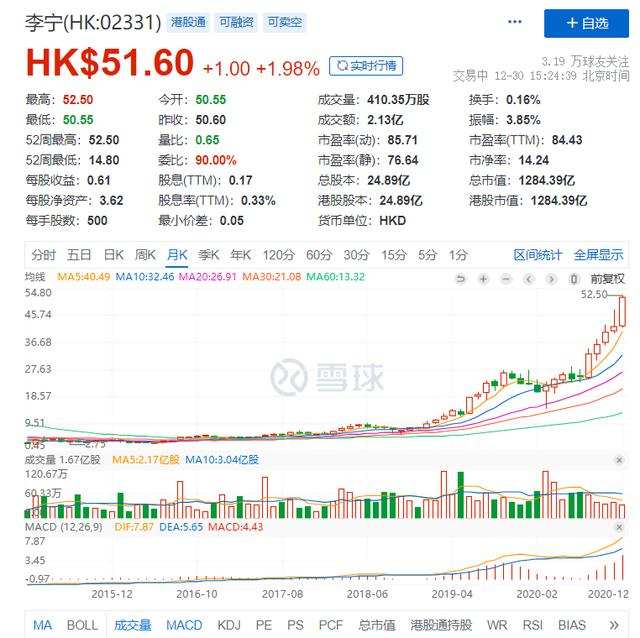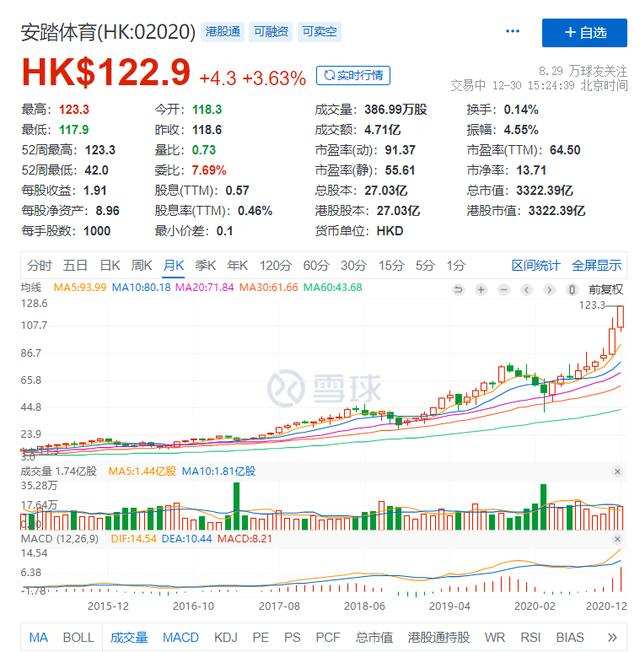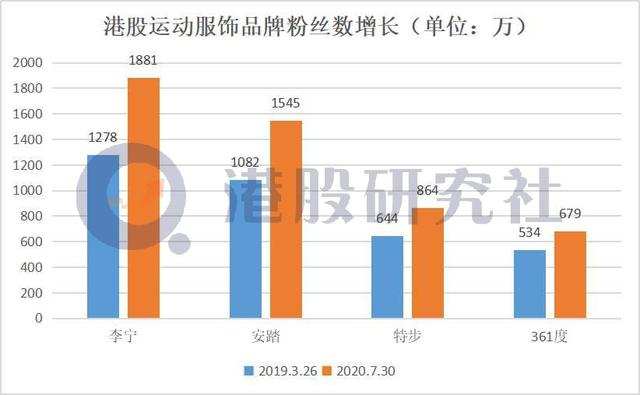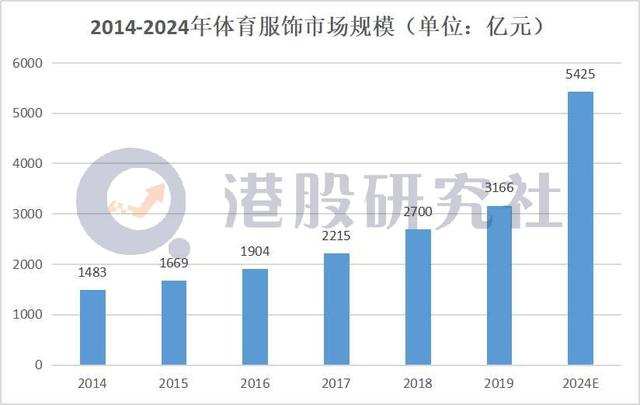With the recovery of economic growth, the terminal consumption of sportswear will further recover, driving the normalization of industry inventory and discount levels.
2020 is the “year of suffering” for many business sectors, and apparel brands will inevitably be swept by the “storm” of the public health crisis at the beginning of the year. The cumulative value of sales from January to October is still in a year-on-year decline. In particular, sportswear brands and sports-style casual trendy clothing promoted by the national tide are even more affected due to the significant decline in demand for outdoor activities.
However, with the gradual control of the epidemic and the gradual recovery of consumption, this sector seems to usher in some turning points. On December 28, sports goods stock Li Ning rose more than 3%, Anta rose more than 2%, and the two stocks both hit a record high. As of press time, Li Ning reported 51.6 Hong Kong dollars, up 1.98%, and Anta reported 122.9 Hong Kong dollars, up 3.63%. Goldman Sachs has also re-adjusted its expectations for the Chinese sportswear market, and the industry seems to be nearing spring.
Although clothing is a rigid consumer demand, the industry level has been flat in the first 20 years and underperformed the market. In such a big environment, what is the secret of the prosperity of sportswear industries such as Li Ning and Anta that are getting more and more attention from the market? Can Li Ning and Anta, whose market value has repeatedly hit new highs, keep the market confident in the growth of the sportswear industry for a long time?
Sportswear brands are emerging
Li Ning and Anta have begun to grow into industry leaders after experiencing the early trial and error phase. Anta’s strategy is to expand its brand footprint through acquisitions. Anta recorded a total of 33.9 billion in revenue in 2019, of which the FILA brand was 14.77 billion, accounting for 43.6%, a year-on-year increase of 73.9%. It can be said that it helped Anta realize its dream of “recreating an Anta”.
In recent years, the consumer demand of Generation Z groups gradually occupying most of the market has made the “national trend” more and more popular. According to data, in 2019, the keyword search volume of “Guo Chao” increased by 392.66% year-on-year, of which the post-90s and post-00s contributed more than 57.73% of the purchasing power of “Guo Chao”, and the post-95s accounted for 25.8%.Become the largest consumer group in Guochao.
Li Ning has put a unique label on the brand of “China Lining” through the creation of the Guochao brand, which caused Li Ning’s revenue to grow from 8.8 billion in 2017 to 13.9 billion in 2019. In the third quarter of 2020, Li-Ning’s e-commerce channel flow rate has further improved, with a low growth rate of 40%-50%. This kind of performance is not difficult to understand why the market value of Li Ning and Anta has reached a new high.
Looking at the sportswear sector of the Hong Kong stock market, in addition to Li Ning and Anta, there are also some players that have maintained relatively considerable performance growth. 361 Degrees achieved operating income of 5.63 billion yuan in 2019, a year-on-year increase of 8.6%; net profit attributable to the parent was 430 million yuan, a year-on-year increase of 42.4%. Xtep International achieved operating income of 8.183 billion yuan in 2019, a year-on-year increase of 28%; net profit attributable to parent company was 728 million yuan, a year-on-year increase of 11%. .
The reason why the Hong Kong stocks sportswear sector has emerged in the context of the overall sluggish apparel industry is that, on the one hand, it stems from the general trend of consumption upgrades and the continued popularization of national fitness sports. The sportswear industry has a huge market potential. According to Euromonitor International’s forecast, The compound annual growth rate of the sports shoes and apparel market in the next five years will reach 10.42%, which is significantly higher than the overall growth rate of the apparel industry. The industry scale is expected to reach 43,464,600 yuan in 2023.
On the other hand, the Hong Kong stock market also recognizes apparel brands. As of July 9, 2020, there are only 7 apparel companies with a stock market value of 10 billion yuan. Among them, the market value of Hailan House with the highest market value is only 27.625 billion yuan. However, in the Hong Kong stock market, there are 9 companies with a market value of tens of billions. From the perspectives of financing, pricing, and liquidity, apparel companies are more willing to go public in Hong Kong.
In this way, the unique beauty of the Hong Kong stocks sportswear segment seems to be the general trend, but when it is enlarged to the global market, Anta and Li Ning have many competitors. In the increasingly fierce competitive environment, they want to continuously improve brand competition. It is not easy to get out of the fundamentals.
However, looking at the entire apparel market, the branch of sportswear in the past two years seems to have taken a completely different path from the fast fashion brands that had been the leader in previous years.
Fast fashion “slow down” on the sportswear bar
The domestic sportswear brands mentioned above have been remarkable in recent years. However, in horizontal comparison, fast fashion brands such as Uniqlo and H&M are all inThe influence of the brand is also expanding, which in turn has an impact on the sportswear sector.
Due to the gradual slowdown of the domestic economy and residents’ income growth, consumers have begun to get rid of their blind worship of high-end brands and high unit prices. With the explosion of commercial real estate and the return of consumers to rational consumption, fast fashion brands have risen, and many foreign fast fashion brands such as H&M, KM, ZARA, Forever 21, and many other foreign fast fashion brands have opened the era of “horse racing enclosure” for nearly 10 years.
According to the National Bureau of Statistics, the number of Generation Z in China in 2019 has exceeded 226 million, accounting for 16% of the total population. According to McKinsey’s 2019 Fashion Business Report, Gen Z will continue to provide a 3.5%-4.5% growth rate for the fast fashion industry.
But in the past two years, many brands in the apparel sector have lost the market. In December 2018, New Look announced on its official WeChat public account, official Weibo and Tmall flagship store that it would close Chinese stores and Tmall flagship stores; In September 2019, TOPSHOP also announced its withdrawal from the Chinese market; La Chapelle, a women’s clothing brand, also closed about 4,400 stores last year.
Fast fashion brands also feel the pain of the reshuffle period. Last year, Old Navy, a sub-brand of American fast fashion brand GAP, also said it would withdraw. This year Esprit announced its full withdrawal from the Asian market, which is better than ZARA. Its parent company Inditex also announced the closure of 1,200 stores worldwide in June this year.
Fashion once quickly seized the market with its novel styles and rapid updates. But with the global retail downturn, fast fashion has also lost immunity, and more and more fashion brands have entered the field of vision of young people. In addition, fast fashion has relaxed its quality control in recent years, so the market performance has gradually declined. .
In this context, many fast fashion brands are currently exploring the path of sustainable development. For example, Uniqlo is pushing the concept of environmental protection this year. At present, GAP is also simplifying product configuration, focusing on the four pillars of jeans, khaki pants, T-shirts, sweaters, and pants.
Sportswear should have been chasing after victory, but the epidemic at the beginning of the year also led to frequent bad news in this sector. Xtep expects that its net profit in the first half of the year will decrease by 45%-55% year-on-year; FILA Holdings’ first quarter 2020 financial report data shows that sales will achieve approximately US$652 million, a year-on-year decrease of 5.3%; net profit will achieve approximately US$33 million, A year-on-year decrease of 58.9% compared to the previous year; Adidas’s revenue in the first quarter of 2020 fell 19% year-on-year to 4.75 billion euros, and its net profit fell from 632 million euros to 31 million euros, a total drop of 95%.
With the gradual control of the epidemic, the performance of domestic sportswear brands such as Anta and Li Ning has begun to continue to stabilize, but at the same time, fast fashion brands that are not waiting to die are continuing to help themselves. Who can take the leadRelying on the accumulated deep management and operation barriers and the brand matrix built to stabilize the moat and consolidate the growth logic, it is still unknown for the time being.
Can the industry’s accumulation of power bring about a sustained increase in overall valuation?
Whether it is the competition with fast fashion brands or the performance of sportswear in recent years, they actually reflect the potential of this track. Not only that, the overall valuation of the industry in the future seems to have a trace.
First of all, after the epidemic, the public’s awareness of exercise will also be further improved. Secondly, the increase in national income will bring about an upgrade in the consumption of sports-related products, and the country is also increasing policy support for the sports industry. It can be foreseen in the future. China’s sports shoes and apparel market will continue to expand and is expected to continue to grow in the future.
At the same time of rapid growth, according to the “2019 China Apparel Market Report”, the top five brand apparel companies in China are Adidas, Nike, Hailan Home, Uniqlo and Anta, with their respective market shares It is 1.9%, 1.9%, 1.1%, 1.0% and 1.0%. The market share is relatively scattered, and the competition environment in the track is relatively harsh.
The first is to face the impact of competitors who are more homogenized in the same sector. Using a pair of yoga pants to pry up the tens of billions market, lululemonQ3, a textbook-style successful brand case in the sportswear market, has revenue of $1.117 billion, a year-on-year increase of 21%. As of the fourth fiscal quarter of June this year, online sales, which accounted for 30% of total revenue in Nike’s business framework, increased by 75%, and sportswear brand Athleta’s sales increased by 35% in the third quarter. It can be seen that not only lululemon, but also head sports brands and small-scale sportswear brands have collectively achieved significant growth.
In addition, some luxury brands are also targeting the high-end market in sportswear. Such as Fendi’s sportswear series, Versace’s sports bra, Moncler’s ski leggings, Tory Burch, Chloe and Stella McCartney has launched a sportswear series.
However, it is worth noting that there are still some uncertainties in the epidemic. According to data, on December 29, Dalian, Beijing, Shenyang, Chengdu, Tianjin and other cities had new confirmed cases; for Beijing, from December 14 to 26, a total of 13 new confirmed cases People infected with new coronary pneumonia. As a relative home, a new round of tests for outdoor sportswear is coming.
In short, with the recovery of economic growth, the terminal consumption of sportswear will further recover, driving the return of industry inventory and discount levels to normalization. According to Goldman Sachs’ expectations, the compound annual growth rate of revenue in the Chinese sportswear market from 2019 to 2025 can reach 10%.
So in the future, in the environment where the valuation of the leading consumer goods in other industries continues to increase, the overall increase in the valuation of the leading sportswear is relatively reasonable. However, for some domestic sportswear brands, it is still a long-term road to seek development in the game if they want to enhance the voice of the industry in the fierce competition environment and bring better profit prospects.
The source of the article: Hong Kong Stock Research Institute. Please indicate the copyright for reprinting.




